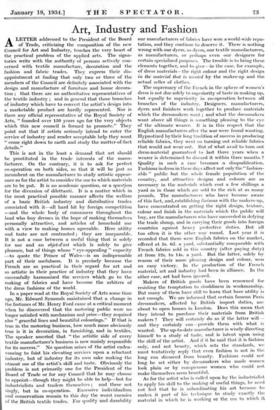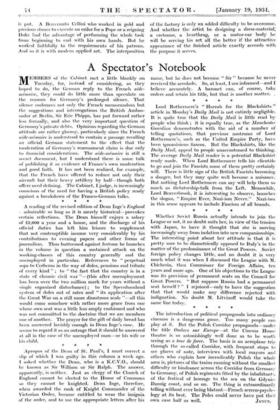Art, Industry and Fashion
ALETTER addressed to the President of the Board of Trade, criticizing the composition of the new Council for Art and Industry, touches the very heart of the practical problem of the applied arts. The signa- tories write with the authority of persons actively con- cerned with textile manufacture, decoration and " the fashion and fabric trades. They express their dis- appointment at finding that only two or three of the members of the Council are definitely associated with the design and manufacture of furniture and house decora- tion ; that there are no authoritative representatives of the textile industry ; and in general that those branches of industry which have to convert the artist's design into a marketable product are hardly represented. Nor is there any official representative of the Royal Society of Arts, " founded over 150 years ago for the very objects which this new council is formed to promote." They point out that if artists seriously intend to enter the service of industry and render acceptable help they must " come right down to earth and study the matter-of-fact details."
This is not in the least a demand that art should be prostituted in the trade interests of the manu- facturer. On the contrary, it is to ask for perfect co-operation on both sides, so that it will be just as incumbent on the manufacturer to study artistic appear- ance as for the artist to consider the use to whiCh materials are to be put. It is no academic question, or a question for the diversion of dilettanti. It is a matter which in the most practical possible manner affects the welfare of a basic British industry and distributive trades associated with it—all hard hit by foreign competition —and the whole body of consumers throughout the land who buy dresses in the hope of making themselves personally attractive, and articles of household use with a view to making homes agreeable. Here utility and taste are not contrasted ; they are inseparable. It is not a case between a useful thing that is solely for use and an objet-d'art which is solely to give pleasure, but of things whose " eye-appealing " capacity —to quote the Prince of Wales—is an indispensable part of their usefulness. It is precisely because the French are so practical in their regard for art and so artistic in their practice of industry that they have successfully harmonized the services which go to the making of fabrics and have become the arbiters of the dress fashions of the world.
In a paper read at the Royal Society of Arts some time ago, Mr. Edward Symonds maintained that a change in the fortunes of Mr. Henry Ford came at a critical moment when he discovered that the motoring public were no longer satisfied with mechanism and price—they required also " graceful lines and beautiful colourings." If that is true in the motoring business, how much more obviously true is it in decoration, in furnishing, and in textiles. The speaker asserted that " the artistic side of every textile manufacturer's business is now mainly responsible for its success." No question arises of the artist endea- vouring to foist his elevating services upon a reluctant industry, but of industry for its own sake making the utmost use of the artist's skill and taste. Obviously the problem is not primarily one for the President of the Board of Trade or for any Council that he may choose to appoint—though they might be able to help—but for industrialists and traders themselves ; and these not singly, but in co-operation. Excessive individualism and conservatism remain to this day the worst enemies of the British textile trades. For quality and durability our manufacturers of fabrics have won a world-wide repu- tation, and they continue to deserve it. There is nothing wrong with our dyers, as dyers, our textile manufacturers, as manufacturers, or perhaps even our designers for certain specialized purposes. The trouble is to bring these elements together, and to give—in the ease, for example, of dress materials—the right colour and the right design in the material that is wanted by the maker-up and the actual seller of clothes.
The supremacy of the French in the sphere of women's dress is not due solely to superiority of taste in making up, but equally to superiority in co-operation between all branches of the industry. Designers, manufacturers, dyers and finishers work together to produce materials which the dressmakers want ; and what the dressmakers want above all things is something pleasing to the eye of the ultimate wearer. It is in this respect that the English manufacturers after the war were found wanting. Hypnotized by their long tradition of success in producing reliable fabrics, they went on turning out reliable fabrics that would not wear out. But of what avail to turn out dress-material guaranteed to last three years when a wearer is determined to discard it within three months ? Quality in such a case becomes a disqualification. Fashions in dress in these days affect not only the "fashion- able " public but the whole female population of the country, and attractive designs and colours are as necessary in the materials which cost a few shillings a yard as in those which arc sold to the rich at as many pounds. The manufacturers who have become aware of this fact, and, establishing liaisons with the makers-up, have concentrated on getting the right design, texture, colour and finish in the materials which the public will buy, are the manufacturers who have succeeded in defying the trade slump, and in carrying their goods into foreign countries against heavy protective duties. But all too often it is the other way round. Last year it is recorded that there were English fabrics on the market, offered at 5s. 6d. a yard, substantially comparable with French fabrics sold in this country (after paying duty) at from 12s. to 14s. a yard. But the latter, solely by reason of their more pleasing design and colour, won an easy victory. In the production of the French material, art and industry had been in alliance. In the other case, art had been ignored.
Makers of British goods have been renowned for resisting the temptation to shoddiness in workmanship. But many of them have still to learn that bare utility is not enough. We are informed that certain famous Paris dressmakers, affected by British import duties, are about to open houses in London. Does this mean that they intend to purchase their materials from British makers ? They will certainly do so if the latter will— and they certainly can—provide them with what is wanted. The up-to-date manufacturer is wisely directing himself to a study of taste, and is intent upon using the skill of the artist. And if it be said that it is fashion only, and not beauty, which sets the standards, we must tentatively reply that even fashion is not in the long run divorced from beauty. Fashions could not long be set either by dressmakers who made women look plain or by conspicuous women who could not make themselves seem beautiful.
As for the artist who is called upon by the industrialist to apply his skill to the making of useful things, he need not feel that he is subordinating his art because he makes it part of his technique to study exactly the material in which he is working or the use to which it is put. A Benvenuto Cellini who worked in gold and precious stones to execute an order for a Pope or a reigning Duke had the advantage of perforthing the whole task from beginning to end with his own hands. But he worked faithfully to the requirements of his patrons. And so it is with modern applied art. The interposition of the factory is only an added difficulty to be overcome. And whether the artist be designing a dress-material; a cretonne, a liearthrug, or a motor-car body' he will be serving his art all the better if the attractive appearance of the finished article exactly accords with the purpose it serves.









































 Previous page
Previous page